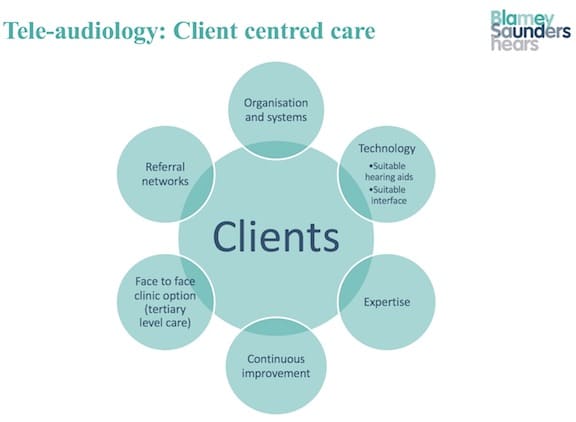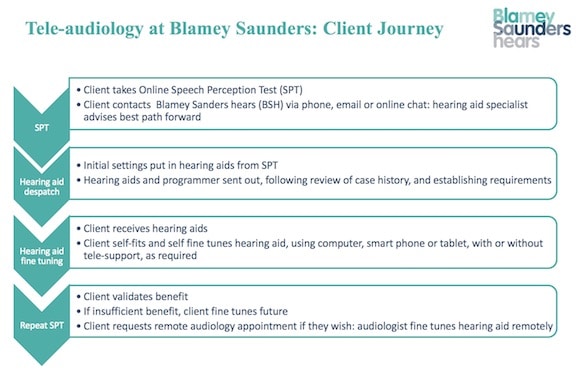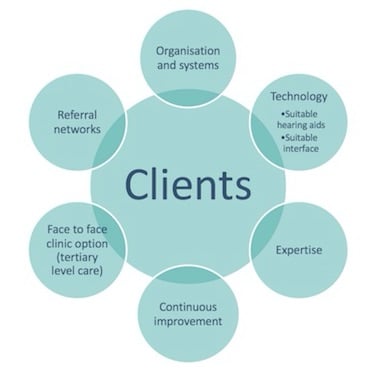The past weeks’ posts from ‘Down Under’ by Dr. Elaine Saunders have described an innovative approach to managing the unmet needs of hearing-impaired individuals – a hearing loss solution model she feels can have universal application. This post, the final of a four-part series written by Dr. Saunders, describes the model followed to manage these issues.
by: Elaine Saunders, Ph.D.
The Model
The person who has hearing difficulties takes the Blamey Saunders Speech Perception Test (SPT) on-line. This test has been shown to be predictive of the pure-tone audiogram{{1}}[[1]]Blamey, P. and Saunders, E. (2015) Predicting speech perception from the audiogram and vice versa, Canadian Audiologist, Vol. 2, Issue 5, 2015[[1]] and is carried out at comfortable levels. Test results demonstrate to the listener which sounds of speech they hear well and which they have difficulty with. We also use this test in our clinic. It is much easier to use for informational counselling than is the audiogram. The test results are analysed and made available to the individual immediately.

The results from the SPT are also stored in the Blamey Saunders central database. The SPT is self-explanatory and informative for the client. The test result provides a baseline of performance against which the benefit of hearing aids can be measured. The results can also be used to set up the initial settings in the hearing aids. This is an exciting innovation, as it is a development from the prediction of hearing aid outputs from pure-tone thresholds, which need expensive infrastructure and where there is no solid agreement around “the best” formula to use{{2}}[[2]]Mueller, H. (2006) Fitting hearing aids to adults using prescriptive methods: An evidence-based review of effectiveness; J Am Acad Audiol 16; 448–460[[2]].
If hearing aids are ordered, we then send the hearing aids to the client’s home, with the initial settings. Most clients phone before ordering, and the Blamey Saunders phone triage team start a client history to give some background to the client’s situation. When the client receives the hearing aids, he/she is encouraged to balance loudness of in-situ sounds produced by the hearing aids to overcome individual differences in ear canal acoustics and loudness preferences across frequencies. Then the client has some choices. They can use the initial settings, they can fine tune the hearing aids themselves, or they can ask for help – which we do for them remotely.

The client receives a kit with their hearing aids that includes an attractive Bluetooth® programming interface and instructions on how to set it up. Some people don’t use it – they take their hearing aids out of the box and use them happily, and successfully. We telephone everyone to make sure they are okay. However, most people use the programming interface to fine tune their hearing aids. That’s what we prefer, because research shows that gives better results. If they have trouble, or aren’t confident, then they email or call us, and we take over in difficult cases.
The client connects their hearing aids to the cables of the programming interface (we call it the Incus) and then activates the software on their Smartphone, tablet or PC. The Incus is Bluetooth to the computer or Smartphone. We could have made it wireless to the hearing aids, but this is not a remote. It’s the programmer. We didn’t want the clients to be fiddling all the time. So, clients set up their hearing aids and then move on, gadget free. They can set up four programs in the hearing aids if they want. The Everyday program will suit most situations but if a client has to operate in what I call “Extreme Listening” situations, they can set up a program in that environment. One of my favourite examples of extreme listening is the client who’s an aging rock star, so we need a programme for use with amplification and loud music that is meant to be loud. A less glamorous example is the barista, who has to spend their days operating a really noisy machine. They can use the Incus and their mobile to set up a special barista programme without looking too nerdy at work.
When the client opens their package and connects the components, most people find it easy, but many older people don’t update their computer all that often, so we have to help them set up our software on old systems. Once this is done, they are on a roll. They also know we are only a click or a phone call away. And, that’s the point. The audiologist can do things remotely, can have a hearing aid that’s “trainable,” or an automatic self fit, but has to be there when there’s a need. As clinicians, we have to identify the people that need help. That’s why I think a mixed service product is so much better than abandoning people to some kind of automatic system which doesn’t capitalize on personal buy-in and empowerment, and doesn’t have a back-up plan. A service model needs to be well thought out.
So, we have the hearing test results; we’ve sent out the hearing aids; they’ve been fine tuned, with or without help; we also encourage people to re-do the SPT with their hearing aids on. They will see a big difference – if, by any chance they don’t, then we can jump in to help. We have the data.

I believe we have found the ideal remote audiology cost vs service mix. Those people who want to be independent can be and those who want or need help get it.
Blamey Saunders hears has a team of 25, almost half of whom are clinicians. We work with people all over the world, and the business is scalable, so the Blamey Saunders hearing aids are priced much lower than premium hearing aids in more traditional models, and without compromising on quality. We are extremely connected to our clients. In this model of care, service is generally accommodated within 24 hours, depending on the need, as Blamey Saunders is only a click away.
Life for audiologists is about to become hugely exciting. Audiologists will either be servicing clients over a big geographical area, or be seeing interesting clients who really need our help because they can’t help themselves. We will be where we should be, at tertiary level care.
It’s the best time ever to be in audiology. Blamey Saunders is leading hearing aid and audiology practice in tele-audiology in Australia. Indeed, audiology is leading tele-health in Australia. Above all, we have the greatest respect for our client – the person who wants hearing aids. We have built a technology and service system to meet the needs of clients in 2015 and beyond.
Tele-audiology needs planning and preparation; appropriate tools and infrastructure and appropriate enabling technology. The Blamey Saunders centralised data systems and online Speech Perception Test are key to good client management, to good outcomes, and to continuous product and service improvement.
This is Australia’s answer, and it works. The model, which is very technologically comprehensive and innovative behind scenes, is sustainable and our clients love the convenience and the readily available support. A major part of the innovation is that Peter Blamey has lead the development of the signal processing for a very, very good hearing aid that enables us to make the whole IHearYou® system very easy for a client to use.
It can be tough being a disruptor, even if you know you are striving to deliver the best in outcomes for clients. You are bound to offend some people who are entrenched in older models of care.
I’m proud to say that our genuine goals and our expertise in implementation were recognized by the Australian Good Design Council as the leaders in the category of Social Innovation. The overall winner was Tesla – hard to beat a car.
Note
IHearYou® is a trademark of Blamey Saunders hears®







